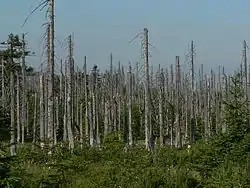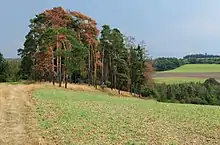Forest dieback
Forest dieback (also "Waldsterben", a German loan word) is a condition in trees or woody plants in which peripheral parts are killed, either by pathogens, parasites or due to conditions like acid rain and drought.[1] Two of the nine tipping points for major climate changes forecast for the next century, are directly related to forest diebacks.[2]

Definition
Forest dieback refers to the phenomenon of a stand of trees losing health and dying without an obvious cause. This condition is also known as forest decline, forest damage, canopy level dieback, and stand level dieback (also Waldsterben and Waldschäden, German loan words).[3] This usually affects individual species of trees, but can also affect multiple species. Trees and woody plants are killed by a complex group of factors that include parasites, such as fungus and beetles, pollution, such as acid rain and organic compounds, and drought.[1] Diseases and pests can kill large groups of trees very easily, but the premature and progressive loss of clusters of trees without an obvious or specific cause is known as forest dieback. Dieback is an episodic event.[3] Dieback takes on many locations and shapes. It can be along the perimeter, at specific elevations, or dispersed throughout the forest ecosystem.[4]
Forest dieback has many symptoms: falling off of leaves and needles, discoloration of leaves and needles, thinning of the crowns of trees, dead stands of trees of a certain age, and changes in the roots of the trees. Forest dieback has many dynamic forms. A stand of trees can exhibit mild symptoms, extreme systems, or death at the same time. Forest decline can be viewed as the result of continued, widespread, and severe dieback of multiple species in the forest.[3] Current forest decline is described by rapid development on individual trees, occurrence in different forest types, a long duration (over 10 years), and occurrence throughout the natural range of affected species.[4]
History
Much research was done in the 1980s when a severe dieback happened in Germany and the Northeast United States. Previous diebacks were regionally limited, but starting at the end of the 1970s a decline took over the forests of Central Europe and parts of North America. The forest damage in Germany was different because the decline was severe, up to 50% of the trees, prolonged, over 5 years, and widespread across tree species. Affected trees went from 8% in 1982 to 50% in 1984 and stayed at 50% through 1987.[4] Many hypotheses have been proposed for this dieback, see below.
Drought and temperature (heat stress) have been causal factors in many diebacks. This condition is common in semi-arid regions and the trees are already stressed by dehydration. There have been reported diebacks in the 50% mortality range across multiple species in Africa, Asia, Europe, North America, South and Central America, and Australia. Notable drought related diebacks have occurred globally from the 1970s through the 2000s. A few drought related diebacks have occurred before this. For instance, a 23% mortality rate was reported between 1945 and 1993 in Senegal Africa.[5] Trees stressed by drought and temperature are more susceptible to parasites.[3]
In North America there were five notable hardwood diebacks in the 20th century. These have occurred with the maturation of the forest and each episode has lasted about eleven years. The most severe temperate forest dieback was on white birch and yellow birch trees. The others are ash, oak, and maple species. White and yellow birches experienced an episode starting between 1934 and 1937 and ending between 1953 and 1954. This followed a wave pattern that first appeared in southern regions and moved to northern regions. A second wave is evident between 1957 and 1965 in northern Quebec. Sugar maple experienced a wave of dieback in parts of the United States during the 1960s. A second wave occurred primarily in Canada during the 1980s, but also reached the United States. These diebacks were numerically analyzed to exclude natural tree mortality. It is hypothesized that a mature forest is more susceptible to extreme environmental stresses.[6]
Pathogens are responsible for many diebacks. It is difficult to isolate and identify exactly which pathogens are responsible and how they interact with the trees. For instance Phomopsis azadirachtae is a fungus of the genus Phomopsis that has been identified as responsible for the dieback in Azadirachta indica (Neem) in the regions of India.[7] Neem is a very hardy and drought tolerant tree, has antifungal and antibacterial properties, but it still has many diseases. Different pathogens affect every part of the tree: the twigs, shoots, leaves, roots, and bark. Scientists have isolated both the fungus and the toxin. They have identified the pathogen in the tissue of all affected trees. Proper knowledge of toxin chemistry and its role in pathogenesis requires further investigations.[7] Some experts consider dieback as a group of diseases with incompletely understood origins influenced by factors which predispose trees under stress to invasion.[3]
Top dying disease is a disease of Heritiera fomes, the dominant species of mangrove tree growing in the Sundarbans. This disease has become more prevalent since about 1970 and may be linked to an increase in the heavy metal concentration of the sediment deposited in the Ganges Delta.[8]
Hypothesis
The components of a forest ecosystem are complex and identifying specific cause–effect relationships between dieback and the environment is difficult. Etiology is the science of identifying the causes of death. Because there is no one single and clear cause of dieback there are multiple hypothesis for the causes and effects of dieback. The following hypotheses were agreed upon between the scientific exchanges of Germany and the United States in 1988.[4]
Soil acidification/aluminum toxicity: As soil becomes more acidic there is a release of aluminum that damages the tree’s roots. Observed effects are: reduction of uptake and transport of some cations, reduction in root respiration, damage to fine feeder roots and root morphology, and reduction in elasticity of the cell walls. This is proposed by Professor Bernhard Ulrich in 1979.[4]
Complex High-Elevation Disease: The combination of high ozone levels, acid deposition and nutrient deficiencies at high elevations kill trees. High ozone concentrations damage the leaves and needles of trees. Nutrients are leached from the foliage. The chain of events is magnified over time. This is proposed by a group of professors: Bernhard Prinz, Karl Rehfuess, Heinz Zöttl.[4]
Red-needle disease of spruce: The symptoms are needle drop and crown thinning. Needles turn a rust color and fall off. This is caused by foliar fungi that are secondary parasites attacking weakened trees. This is proposed by Professor Karl Rehfuess.[4]
General Stress: The increased level of atmospheric pollutants hurts the root system and accumulates toxins in new leaves. Pollutants alter the growth, reduce the photoshythetic activity, and reduce the formation of secondary metabolites. It is believed that low concentrations levels are toxic. This is proposed by a group of professors led by Peter Schütt.[4]
Excess Nitrogen Deposition: The increased level of nitrogen and ammonium, a fertilizer, could have the following possible effects: it could inhibit beneficial fungi, delay chemical reactions, disturbe normal balances between shoot growth and root growth, increase soil leaching. There is no experimental proof. This is proposed by Carl Olaf Tamm.[4]
Organic Air Pollutants: This is similar to the general stress hypothesis, but focuses on organic compounds. The three compounds seriously discussed are ethylene, aniline, and dinitrophenol. Even at low levels these organic chemical compounds have caused: abnormal dropping of foliage, twisted foliage, and killing of seedlings. This is proposed by Fritz Führ.[4]
Global climate change
Changes in mean annual temperature and drought are major contributing factors to forest dieback. As more carbon is released from dead trees, especially in the Amazon and Boreal forests, more greenhouse gases are released into the atmosphere. Increased levels of greenhouse gases increase the temperature of the atmosphere. The feedback loop is reinforced and the biological adaptations of the species determine its survival. Projections for dieback vary, but the threat of global climate change only stands to increase the rate of dieback.[9]
Scientists do not know the exact tipping points of climate change and can only estimate the timescales. When a tipping point - the critical threshold - is reached, a small change in human activity can have long-term consequences on the environment. Two of the nine tipping points for major climate changes forecast for the next century are directly related to forest diebacks. Scientists are worried that forest dieback in the Amazon rain forest[10] and the Boreal evergreen forest[11] will trigger a tipping point in the next 50 years.[2]
See also
- Bark beetle
- Birch dieback
- Forest pathology
- Heat wave
- Hymenoscyphus fraxineus – cause of ash dieback
- Kauri dieback
- Permanent wilting point
References
- "Climate-induced forest dieback: an escalating global phenomenon?". Food and Agricultural Organization (FAO). 2009. Retrieved March 16, 2010.
- "'Tipping points' could come this century". University of East Anglia. February 5, 2008. Retrieved March 16, 2010.
- Ciesla, William M., Donaubauer, Edwin. (1994) Decline and dieback of trees and forests: A global overview. Rome, Italy: Food and Agriculture Organization of the United Nations.
- Krahl-Urban, B., Papke, H.E., Peters, K. (1988) Forest Decline: Cause-Effect Research in the United States of North America and Federal Republic of Germany. Germany: Assessment Group for Biology, Ecology and Energy of the Julich Nuclear Research Center.
- Allen, C.D., et al. (2009) A Global Overview of Drought and Heat-induced Tree Mortality Reveals Emerging Climate Change Risks For Forests. Forest Ecology and Management, 259, 660–684. doi:10.1016/j.foreco.2009.09.001
- Auclair, A.N.D., Eglinton, P.D., Minnemeyer, S.L. (1997) Principle Forest Dieback Episodes in Northern Hardwoods: Development of Numeric Indices of Aereal Extent and Severity. Netherlands: Kluwer Academic Publishers.
- Girsh, K., Shankara Bhat, S. (2008) Phomopsis azadirachtae – The Die-Back of Neem Pathogen. Electronic Journal of Biology, 4(3), 112-119.
- Awal, M.A.; Hale, W.H.G.; Stern, B. (2009). "Trace element concentrations in mangrove sediments in the Sundarbans, Bangladesh". Marine Pollution Bulletin. 58 (12): 1944–1948. arXiv:1506.05421. doi:10.1016/j.marpolbul.2009.08.016.
- Allen, C.D. (2009) Climate-induced forest dieback: An escalating global phenomenon? Unasylva 231/232, 60, 43-48.
- Blaustein, R.J. (2011). Amazon Dieback and the 21st Century. Bioscience, 61(3), 176-182. doi:10.1525/bio.2011.61.3.3
- Krankina, O.N., et al. (1997) Global Climate Change Adaption: Examples From Russian Boreal Forests. Climatic Change, 36, 197–216.
